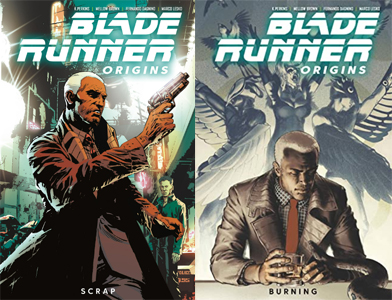Philip K. Dick commented on his own time via stories set in the future. But now our real-world timeline has somehow moved beyond the future. We have passed the fictional years of many SF touchstones — including “Blade Runner,” set in 2019, and its source material, Dick’s “Do Androids Dream of Electric Sheep?,” set in 2021.
So with Titan Comics’ “Blade Runner: Origins” (2021-22) – of which I’m reviewing Volume 2, “Scrap,” and the conclusive Volume 3, “Burning” – we have the odd situation where writers K. Perkins and Mellow Brown comment on present-day issues via a story set in 2009. Well, the 2009 of the “Blade Runner” reality.
It fails to make its case as a necessary story
I noted in my review of “Volume 1: Products,” that it’s odd that a Tyrell Corporation scientist can transfer her mind into a Nexus-5 prototype. That would seemingly make them more advanced than the Nexus-6s we are familiar with from the “Blade Runner” film.

“Blade Runner: Origins” Issues 5-12 and Free Comic Book Day issue (2021-22)
Subtitles: “Volume 2: Scrap” and “Volume 3: Burning”
Writers: K. Perkins and Mellow Brown
Artist: Fernando Dagnino
Colorist: Marco Lesko
The writers ultimately address this issue. This prequel series ends up a little like the “Star Wars” prequels in that some technology takes a step backward for sociopolitical reasons. One difference, though: The “Star Wars” prequels demanded to be told; we wanted to know how Anakin became Vader. This “Blade Runner” prequel is narratively unnecessary.
When we meet Rick Deckard and Roy Batty, it’s a time when blade runners with a conscience are hunting replicants with a conscience. That Dickian irony need not have a complex backstory, since it’s like any cops-and-criminals story that digs into gray areas.
Authors find their voice in the end
However, “unnecessary” isn’t the same thing as “pointless.” While Volume 2 is meandering and confusing – causing me to return to the opening text crawl many times to keep the characters and their statuses straight – Volume 3 ends up being compelling.
Perkins and Brown portray Sector 6-B in Los Angeles as a typical inner-city neighborhood. The government is using the sector’s school system as a place to try out new replicant teachers, pitching it as an improvement even though the residents prefer their human teachers.
Ironically, Sector 6-B is also where Nexus-4s – made to question their plight as slaves by Nia Moreaux, the aforementioned human who transferred herself into a prototype Nexus-5 – have formed a Replicant Underground.
Sector 6-B includes a drag queen, a woman who has transferred her essence into a male replicant (a metaphor for transgenderism), and a black woman styled after Pam Grier. The brother of the transgender replicant is transphobic, and – when he ends up needing a safe place himself — the writers make it a point to kick him out of the sector. There’s room for everyone in Sector 6-B except bigots.

While this makes “Blade Runner’s” timeline “woke” 10 years before the real world’s, it also makes this series about something – which is refreshing after the clunky second volume. The writers are good at sociopolitical soapboxing, but not as comfortable with sociopolitical backdoor intrigue.
Soapboxing and backdoor intrigue
Nia’s brother, Cal Moreaux – a cop who we know will become the first blade runner – has become an ally to the Underground throughout “Origins.” So how does he, of all people, become the first blade runner?
(SPOILERS FOLLOW.)
In the grand finale, Nia asks Cal to make her a martyr and himself an undercover helper of the Replicant Underground. He agrees. He kills Nia as Nia pretends to try to assassinate Tyrell Corp’s Ilora Stahl during a live television interview.
The “hero” Cal is then set up by the LAPD as the first blade runner, and the head of the unit. In hiring other blade runners, he’ll look for people who aren’t obviously empathetic toward replicants, but also who aren’t pure unemotional killers – cops who have the capacity to become better people but aren’t there yet. (Think Rick Deckard.) That way his bosses won’t question his hires.
This is sort of like Princess Leia becoming a Senator within the Empire, hoping to manipulate it from within while also leading a Rebellion. But in “Star Wars,” this makes sense because the Empire is so terrifyingly powerful. In “Origins,” Nia’s scheme is unnecessarily complex – like something devised by writers rather than a revolutionary.
Still, I suppose if the first blade runner was simply a cop who is excellent at killing replicants, that would land flat. Although maybe not, if all the people around him were well-drawn. Cal, though, had to end up a good guy: Throughout “Origins,” he has looked as bedraggled and internally conflicted as Deckard on his worst day.
The first blade runner: A lot like the later blade runners
Artist Fernando Dagnino does do a better job of making everyone (literally) well-drawn as “Origins” goes forward. Notably, he puts a perpetually haunted look into the eyes of villain Ilora, as if on some level she’s not proud of issuing orders to burn down the replicants’ safe sector and everyone in it, including humans. It could also be that she is terrified for her job, status, livelihood and life: Eldon Tyrell has told her to either get the job done or take the fall personally, sparing the company.
Dagnino has the ability to show people’s emotions, but I wish he used it regularly rather than sparingly. Fight scenes are rote because action comes before facial expression – so much so that I still didn’t know who some of the characters were toward the end.
The writers are also to blame for this, as they tell the story out of order. (The most annoying “out of order” chapter is the incomprehensible Free Comic Book Day 2021 issue tucked into the back of Volume 2.)
As the series moves toward its end, Perkins and Brown finally use flashbacks to fill in the gaps, including a human teacher’s first meeting with a replicant trainee. She initially hates him but then realizes replicants are “human,” too. While these flashbacks are welcome blasts of narrative clarity, I don’t know why the story couldn’t have been told in chronological order.
“Origins” has good characters, but there are too many of them, and each is underexplored. Neither the story nor art is on par with the “2019”/“2029”/“2039” saga of Ash, another blade runner who is secretly helping replicants. But Perkins and Brown do find their voice by the end, and Dagnino finds some facial expressions. While falling short of greatness, “Origins” doesn’t embarrass the “Blade Runner” title.
Volume 2: 2.5 stars
Volume 3: 3 stars

